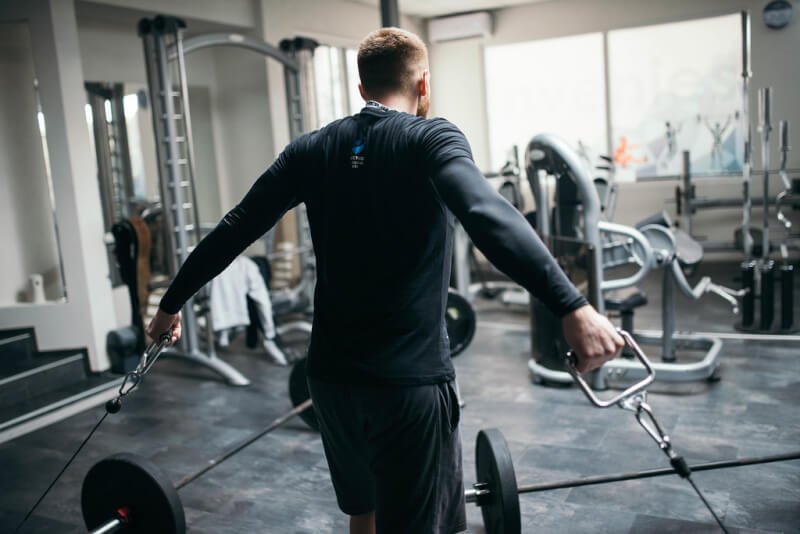You’re on a journey to better health and fitness, but it’s important to be aware of common mistakes that could hinder your progress. In this article, we’ll explore some of these mistakes that many people make when it comes to their fitness routines. By understanding and avoiding these pitfalls, you’ll be well on your way to reaching your goals and achieving optimal fitness. So, let’s jump right in and learn how to steer clear of these common fitness mistakes.

Lack of proper warm-up and cool-down
Skipping warm-up exercises
One of the most common fitness mistakes to avoid is skipping warm-up exercises. Many people underestimate the importance of warming up the body before a workout. Warm-up exercises help to increase blood flow to the muscles, raise body temperature, and prepare the body for the upcoming physical activity. By skipping this crucial step, you are putting yourself at risk of injury and decreased performance during your workout.
Neglecting cool-down exercises
Similarly, neglecting cool-down exercises after a workout is another common mistake. Cool-down exercises allow your body to gradually return to its resting state, help regulate blood flow, and prevent muscle soreness. They also aid in the removal of waste products from the muscles, such as lactic acid, reducing the likelihood of muscle stiffness and post-exercise discomfort. Neglecting this important step can result in muscle tightness, increased risk of injury, and delayed recovery.
Importance of warm-up and cool-down
Both warm-up and cool-down exercises are vital components of a successful fitness routine. A proper warm-up prepares your body for the physical demands of exercise by increasing heart rate, loosening up the joints, and activating the muscles you will be using. Additionally, it mentally prepares you for the upcoming workout, helping you focus and get into the right mindset.
Similarly, cool-down exercises allow your heart rate and blood pressure to gradually return to normal, preventing dizziness and fainting. They also promote recovery by aiding in the removal of metabolic waste, reducing muscle soreness, and assisting in the repair and rebuilding of muscle tissue. By incorporating appropriate warm-up and cool-down exercises into your fitness routine, you will minimize the risk of injury, enhance your performance, and optimize your overall fitness journey.
Overtraining
Not allowing enough rest days
Overtraining is a mistake that many fitness enthusiasts make, often driven by the misconception that more is always better. Pushing yourself too hard without allowing for adequate rest and recovery can lead to a range of negative consequences. One key aspect of overtraining is not allowing enough rest days between intense workouts. Rest days are crucial for your body to repair and rebuild, allowing your muscles, connective tissues, and nervous system to recover from the stress of exercise. By not incorporating rest days into your routine, you increase the risk of injury, hinder your progress, and experience a decline in overall performance.
Ignoring warning signs of overtraining
Another mistake related to overtraining is ignoring the warning signs that your body may be giving you. These signs can manifest as chronic fatigue, persistent muscle soreness, decreased motivation, mood swings, disrupted sleep patterns, and increased susceptibility to illness. Paying attention to these warning signs is essential, as they indicate that your body is not fully recovering from your workouts. Ignoring these signals and pushing through can lead to burnout, injuries, and a plateau in your fitness journey.
Negative effects of overtraining
Overtraining can have several negative effects on both your physical and mental well-being. Physically, overtraining puts undue stress on your muscles, joints, and other bodily systems, increasing the risk of overuse injuries, such as tendinitis or stress fractures. It can also compromise your immune system, making you more susceptible to illness and infections. Mentally, overtraining can lead to feelings of exhaustion, irritability, and a lack of motivation, ultimately dampening your enthusiasm for exercise and hindering your progress. Finding the right balance between challenging yourself and allowing for proper recovery is crucial for long-term success in your fitness journey.

Poor form and technique
Lifting weights with improper form
Using improper form while lifting weights is a common mistake that can have serious consequences. Lifting with poor form not only reduces the effectiveness of the exercise but also increases the risk of injury. It often results in excessive strain on certain muscles or joints, potentially leading to sprains, strains, or even more severe injuries like herniated discs. It is essential to learn and practice proper lifting techniques for each exercise to maximize results and minimize the risk of injury.
Performing exercises with incorrect technique
Similar to lifting weights with improper form, performing exercises with incorrect technique can also lead to injuries and hinder your progress. Each exercise has a specific range of motion and alignment that must be followed to target the intended muscles effectively. Deviating from proper technique can put unnecessary stress on other muscles or joints, resulting in imbalances and potential injuries. It is crucial to seek guidance from a qualified fitness professional to ensure you are performing exercises correctly and efficiently.
Potential injuries due to poor form
The potential injuries caused by poor form and technique can vary in severity. From strained muscles and joint pain to more severe injuries such as tears or dislocations, the risk is significant. Poor form not only compromises the intended muscles’ engagement but can also place excessive strain on surrounding muscles, tendons, and ligaments. Over time, this can create muscle imbalances, decrease flexibility, and limit overall performance. By prioritizing proper form and technique, you will reduce the risk of injury and optimize your workouts for optimal results.
Setting unrealistic goals
Not considering one’s current fitness level
Setting unrealistic goals is an easy trap to fall into when embarking on a fitness journey. Many individuals set lofty goals without considering their current fitness level and capabilities. While it is essential to challenge yourself, it is equally important to set goals that are achievable and realistic within a given timeframe. Failing to account for your starting point may lead to frustration, disappointment, and even giving up altogether. Take the time to assess your current fitness level and set goals that are both challenging and attainable to stay motivated and see progress.
Focusing solely on aesthetic goals
Another common mistake is focusing solely on aesthetic goals, such as weight loss or achieving a specific body shape, without considering other aspects of fitness. While aesthetic goals can be a valid motivator, it is crucial to remember that health and fitness encompass more than just appearances. By obsessing over the number on the scale or a certain body image, you may neglect other aspects of fitness, such as strength, flexibility, cardiovascular health, and mental well-being. By broadening your focus to include these facets, you will not only achieve a more balanced physique but also experience overall improvements in your physical and mental well-being.
Importance of setting SMART goals
To avoid the pitfalls of setting unrealistic goals, it is beneficial to follow the SMART goal-setting framework. SMART stands for Specific, Measurable, Achievable, Relevant, and Time-bound. Specific goals are clear and specific, identifying precisely what you want to achieve. Measurable goals have criteria that allow you to track your progress. Achievable goals are realistic and within your capabilities. Relevant goals align with your overall fitness objectives and are meaningful to you. Finally, Time-bound goals have a set timeframe for completion. By setting goals that align with the SMART framework, you increase your chances of success, maintain motivation, and make continuous progress in your fitness journey.

Neglecting proper nutrition
Not fueling the body with adequate nutrients
Neglecting proper nutrition is a common mistake that can hinder your fitness progress. Exercise places additional demands on your body, requiring the right fuel to support muscle growth, energy production, and recovery. Without providing your body with adequate nutrients, such as carbohydrates, proteins, fats, vitamins, and minerals, you may experience decreased athletic performance, muscle breakdown, prolonged recovery, and compromised immune function. To optimize your fitness journey, it is crucial to prioritize nutrition and fuel your body with the right balance of macronutrients and micronutrients.
Overemphasizing calorie restriction
While proper nutrition is important, it is equally crucial to strike a balance and avoid overemphasizing calorie restriction. Many individuals mistakenly believe that the key to achieving their desired physique is to restrict calories severely. However, excessively low-calorie intake can result in nutrient deficiencies, muscle loss, decreased metabolism, and inadequate energy levels for optimal performance during workouts. Instead of focusing solely on calorie counting, it is important to prioritize nutrient-dense whole foods and establish a healthy relationship with food. Consulting with a registered dietitian or nutritionist can help you develop a personalized nutrition plan that supports your fitness goals while promoting overall health and well-being.
Importance of balanced diet for fitness
A balanced diet plays a crucial role in supporting your fitness journey. It provides the necessary nutrients for muscle recovery, growth, and repair, enhances energy levels, and aids in maintaining a healthy body composition. A balanced diet includes a variety of nutrient-dense foods, such as lean proteins, whole grains, fruits, vegetables, and healthy fats. It is important to prioritize quality and diversity in your food choices, ensuring you get an array of vitamins, minerals, and antioxidants. By nourishing your body with a balanced diet, you will enhance your athletic performance, improve recovery, and maximize your fitness potential.
Inconsistency in workout routine
Skipping workouts frequently
Another common fitness mistake is being inconsistent with your workout routine and frequently skipping workouts. Skipping workouts hinders progress and slows down your fitness journey. Regular exercise is vital for muscle development, cardiovascular health, flexibility, and overall fitness. When you skip workouts, you miss out on the cumulative benefits of consistent training, such as improved strength, endurance, and body composition. To avoid falling into the trap of inconsistency, it is important to prioritize and schedule your workouts, treating them as non-negotiable appointments with yourself.
Lack of commitment to regular exercise
Inconsistency often stems from a lack of commitment to regular exercise. Commitment involves making exercise a priority despite competing demands and potential obstacles. It requires discipline, perseverance, and a mindset shift to view exercise as a long-term investment in your health and well-being. By cultivating a commitment to regular exercise, you will develop a habit that becomes ingrained in your daily routine, making consistency easier to achieve. Surrounding yourself with a supportive community, setting realistic goals, and finding activities you enjoy can also enhance your commitment and motivation to maintain a consistent workout routine.
Effects of inconsistent training
Consistency is key when it comes to seeing results in your fitness journey. Inconsistent training can have various negative effects on your progress. Firstly, it impairs muscle development and strength gains since regular stimulation is necessary for muscle adaptation. Secondly, it can lead to a decline in cardiovascular fitness and endurance, making it harder to achieve desired fitness goals. Inconsistent training also disrupts the habit-building process, making it easier to skip workouts or fall back into old, unhealthy routines. By staying consistent, you create positive momentum, increase your chances of success, and create a sustainable fitness routine.
Neglecting recovery and rest
Not allowing enough time for recovery
Neglecting recovery and rest is a widespread mistake that can hamper your fitness journey. Exercise creates micro-tears in your muscles, and it is during rest and recovery that these muscles repair and grow stronger. Without adequate recovery time, your body does not have the opportunity to rebuild, leading to overuse injuries, decreased performance, and burnout. It is essential to incorporate rest days into your routine and give your body the time it needs to recharge and repair. Listen to your body’s cues and adjust your training schedule accordingly to optimize recovery.
Ignoring the importance of sleep
Sleep is a fundamental pillar of recovery and overall health, yet it is often overlooked in the pursuit of fitness goals. During sleep, your body repairs damaged tissues, releases growth hormones, consolidates memory, and regulates various physiological functions. Ignoring the importance of sleep can have detrimental effects on your physical and mental well-being. Lack of quality sleep can increase the risk of injuries, decrease cognitive function, impair muscle recovery, and hinder progress towards your fitness goals. Aim for 7-9 hours of quality sleep per night to optimize your recovery and maximize your fitness potential.
The impact of inadequate rest on fitness
Inadequate rest can significantly impact your overall fitness. Without proper rest and recovery, your muscles become fatigued and prone to injury, your energy levels diminish, and your performance suffers. Over time, a lack of rest can lead to chronic fatigue, increased cortisol levels (a stress hormone), hormonal imbalances, and decreased immunity. It is essential to prioritize rest and recovery as an integral part of your fitness journey, allowing your body to adapt and grow stronger. By giving yourself permission to rest, you will experience improved performance, decreased risk of injury, and enhanced overall well-being.
Improper breathing during exercises
Uncontrolled or shallow breathing
Breathing is often an overlooked aspect of exercising, yet it plays a crucial role in optimizing performance. Uncontrolled or shallow breathing can limit the flow of oxygen to your muscles, depriving them of the necessary fuel for optimal function. It can lead to increased fatigue, decreased stamina, and reduced athletic performance. To avoid this common mistake, practice deep diaphragmatic breathing during exercise. Take slow, full breaths, inhaling through your nose and exhaling through your mouth. This technique ensures a steady flow of oxygen, enhances focus, and improves endurance.
Holding breath while lifting weights
Another breathing mistake commonly observed is holding your breath while lifting weights. Holding your breath increases intra-abdominal pressure, which can cause dizziness, lightheadedness, and, in extreme cases, even blackout. It can also impair your form and disrupt proper muscle engagement. Instead, practice coordinated breathing with your movements. Inhale during the eccentric (lowering) phase, and exhale during the concentric (lifting) phase. This breathing pattern provides stability, reduces the risk of injury, and helps you maintain control throughout the movement.
Breathing techniques for optimal performance
Mastering proper breathing techniques can significantly enhance your exercise performance. In addition to deep diaphragmatic breathing and coordinated breathing during resistance training, it is important to adapt your breathing to different types of exercises. For cardiovascular activities, such as running or cycling, focus on rhythmic breathing patterns to synchronize your breath with your strides or pedal strokes. Incorporating controlled breaths into your yoga or Pilates practice promotes relaxation, enhances focus, and maximizes the mind-body connection. By paying attention to your breath during exercise, you will optimize your performance, reduce the risk of injury, and create a more mindful workout experience.
Neglecting proper hydration
Not drinking enough water during workouts
Proper hydration is often overlooked but is crucial for optimal performance and overall health. Inadequate water intake during workouts can lead to dehydration, which impairs cognitive function, decreases endurance, and increases the risk of heat-related illnesses, such as heat exhaustion or heat stroke. To avoid this mistake, it is important to drink water before, during, and after exercise. The American College of Sports Medicine recommends consuming 16-20 ounces of water 4 hours before exercise, 8-12 ounces of water 10-15 minutes before exercise, and 7-10 ounces of water every 10-20 minutes during exercise. Adjust your intake based on the intensity and duration of your workout, as well as environmental factors.
Importance of hydration for performance
Proper hydration is essential for optimizing performance during exercise. Water is involved in almost every bodily function, including temperature regulation, nutrient transport, and waste removal. When you’re properly hydrated, your muscles can work more efficiently, your joints are lubricated, and your cardiovascular system can supply adequate oxygen to fuel your activity. Staying hydrated helps maintain your energy levels, improves focus and concentration, and reduces the risk of cramping and fatigue. By prioritizing hydration, you can elevate your performance and get the most out of your workouts.
Signs of dehydration to watch out for
To ensure adequate hydration, it is important to be aware of the signs of dehydration. Early signs include increased thirst, dry mouth, darker urine, and decreased urine output. As dehydration progresses, symptoms can include headache, dizziness, fatigue, muscle cramps, and a rapid heart rate. Severe dehydration can lead to confusion, decreased sweating, sunken eyes, and even loss of consciousness. To avoid these complications, it is important to listen to your body, drink water regularly throughout the day, and pay special attention to your hydration needs during exercise. Remember, thirst is not always an accurate indicator of your body’s hydration status, so aim to drink fluids consistently, even if you don’t feel thirsty.
Relying solely on cardio exercises
Skipping strength training
While cardiovascular exercise is essential for cardiovascular health, body composition goals, and endurance, relying solely on cardio exercises is a mistake many people make. Omitting strength training from your fitness routine can hinder your progress, as it provides numerous benefits that cardio alone cannot deliver. Strength training helps build lean muscle mass, increases metabolism, improves bone density, enhances functional strength, and protects against age-related muscle loss. It also enables you to achieve a balanced physique by sculpting and toning your muscles. To optimize your fitness journey, it is important to incorporate both cardiovascular and strength training exercises into your routine.
Benefits of incorporating strength training
Incorporating strength training into your fitness routine has numerous benefits. Firstly, it helps build muscle mass, leading to increased strength and improved body composition. Muscle is metabolically active tissue, and the more muscle you have, the more calories you burn at rest. This can aid in weight management and create a leaner, more defined physique. Strength training also enhances functional strength, making everyday activities easier and reducing the risk of injury. Additionally, it can help improve bone density, reduce the risk of osteoporosis, and improve overall bone health. By including strength training in your exercise regimen, you maximize your fitness potential and achieve a well-rounded level of fitness.
Finding the right balance between cardio and strength
To strike the right balance in your fitness routine, it is important to find the appropriate ratio between cardio and strength training. The optimal balance varies depending on personal goals, preferences, and individual needs. However, a general guideline is to aim for a combination of cardiovascular exercise and strength training exercises on most, if not all, days of the week. The American College of Sports Medicine recommends at least 150 minutes of moderate-intensity aerobic activity or 75 minutes of vigorous-intensity aerobic activity per week, along with two or more days of strength training. By finding the right balance for you, you can enjoy the benefits of both types of exercise and maximize your fitness gains.
In conclusion, avoiding common fitness mistakes is vital for optimizing your fitness journey and achieving your desired goals. By addressing the lack of proper warm-up and cool-down, avoiding overtraining, maintaining proper form and technique, setting realistic goals, prioritizing proper nutrition, staying consistent with your routine, allowing for recovery and rest, practicing proper breathing and hydration, and finding the right balance between cardio and strength training, you can navigate your fitness journey with confidence, minimize the risk of injury, and achieve long-term success. Remember, your fitness journey is a personal and unique experience, so listen to your body, be patient, and enjoy the process of becoming the best version of yourself.


